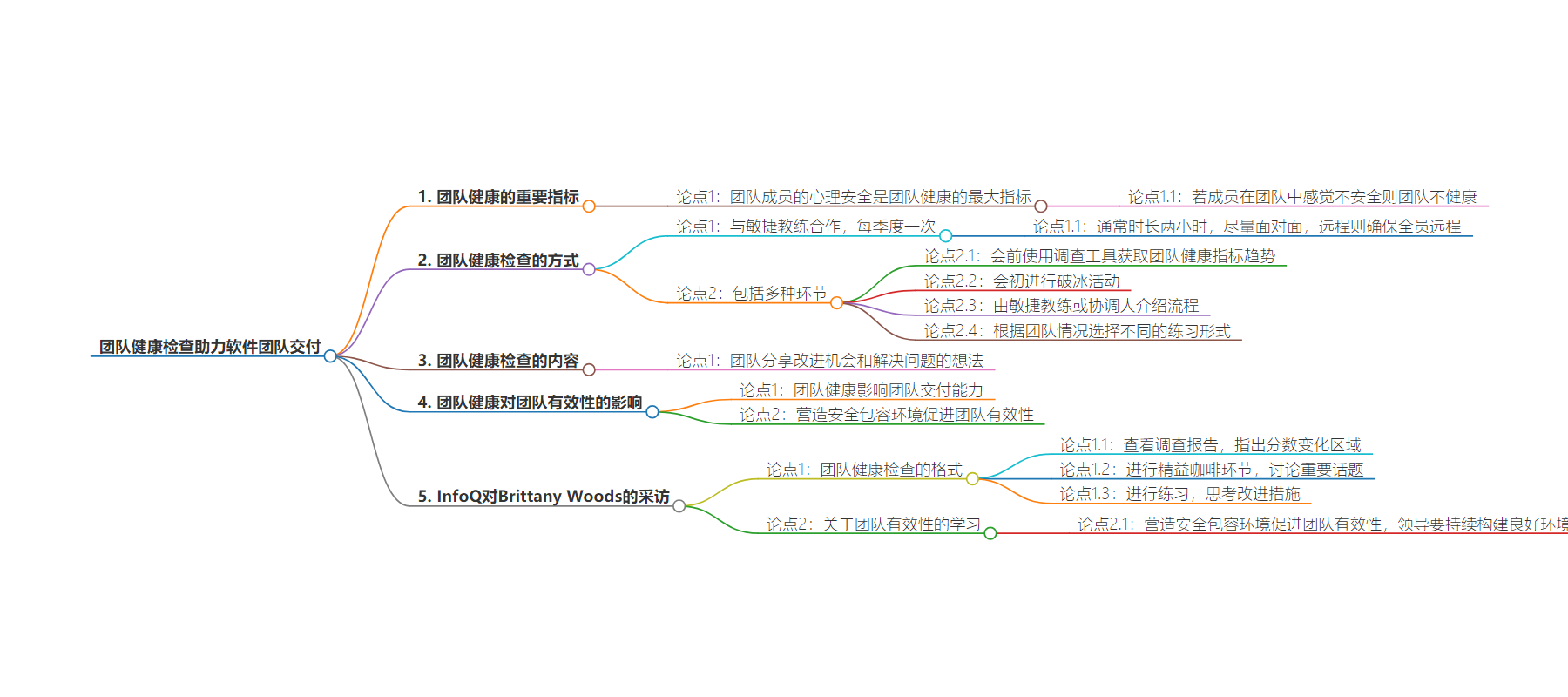包阅导读总结
1.
– 团队健康检查、心理安全、软件团队、团队有效性、协作环境
2.
本文主要介绍了团队健康检查对软件团队的作用。强调心理安全是团队健康的关键指标,通过定期健康检查能了解团队情况,促进团队协作。还分享了检查的形式、流程及从中得到的关于团队有效性的认知。
3.
– 团队健康的关键指标
– 心理安全是团队健康的最大指标,缺乏心理安全团队无法健康发展,尤其在技能和经验混合的团队中很重要。
– 团队健康检查的方式
– 与敏捷教练合作,每季度一次,通常持续两小时,尽量面对面进行。
– 包括分享改进机会和想法,使用调查工具了解团队感受。
– 检查流程
– 会前用调查工具得出团队健康指标趋势。
– 开场破冰,引入环节由外部人员主持。
– 进行如讨论调查结果、精益咖啡环节、解决问题的练习等活动。
– 团队有效性
– 受团队整体健康影响,领导者要营造安全协作环境,促进成员学习、分享和成长。
思维导图:
文章来源:infoq.com
作者:Ben Linders
发布时间:2024/7/25 0:00
语言:英文
总字数:839字
预计阅读时间:4分钟
评分:82分
标签:团队健康检查,心理安全,敏捷教练,软件开发,团队效能
以下为原文内容
本内容来源于用户推荐转载,旨在分享知识与观点,如有侵权请联系删除 联系邮箱 media@ilingban.com
In healthy software teams, people feel psychologically safe to solve problems and contribute, Brittany Woods said in her talk at QCon London. She presented how they do team health checks and the benefits that it has brought them.
The biggest indicator that a team is healthy is the psychological safety of those within the team, Woods said. If not every member is feeling safe within the team to contribute or voice their opinions, it’s not possible for the team to be healthy, she added.
Woods mentioned that this is particularly important in teams where there are mixed skill sets or varied experience levels. In both cases, there is an unwritten power dynamic, so ensuring your team remains a healthy and collaborative team where all members feel safe to solve problems and contribute is very important.
Team health checks are a great way to check in with your software team and get a pulse on how things are going from their perspective, Woods argued:
In my current role, we work with our agile coaches for these health checks, aiming to do them once a quarter.
Woods mentioned that during the health checks, there is time for the team to share things that they believe to be opportunities for improvement along with ideas they may have to solve any identified issues. Their agile coaches facilitate these sessions, making them fun and engaging for the team.
They typically last two hours and they aim for an in-person session, Woods mentioned. Should they do a remote session, they try to ensure all members of the team are remote for a consistent experience across the team.
A typical format would include the following:
- Before the session, they used a survey tool that showed the historical trends and aggregated trends on team health measures, like feeling able to experiment, feeling supported, enjoying the work, feeling trusted, etc. This gave them a baseline of how the team is feeling about the work they are doing. They do this for each health check so they can see if scores are improving or declining.
- At the start of the session, they do an icebreaker to get the team engaged – this can be a game, a fun icebreaker question, or for in-person experiences, they often do the LEGO duck building exercise. This consists of taking 6 bricks and in 60 seconds building a duck. It’s always exciting to see how different people interpret the duck differently.
- The Introduction – the agile coach or facilitator sets the stage for what the session will look like. As an aside, having someone external to the team facilitate the session is important to ensuring a safe and unbiased environment for the team. This also allows the engineering leader to participate as a member of the team.
- The format of the sessions can vary depending on the exercises that would be most valuable for where the team stands in their feedback.
Team effectiveness is very influenced by the overall health of a team, Woods said. From the team environment to quality measures and metrics, team health can either hinder your team’s ability to deliver on their commitments – software or otherwise – or help it, she concluded.
InfoQ interviewed Brittany Woods about doing team health checks.
InfoQ: How does the format of your team health checks look?
Brittany Woods: In our most recent session, we did the following:
- Walk through the survey report, pointing out areas where scores had changed from the previous survey. There was also some unstructured time planned in which each member of the team could review/reflect on the results and put in some sticky notes of their thoughts. We use Miro to collaborate and put in stickies. We then broke out into smaller sub groups and discussed what patterns we found in the data.
- After discussing the survey, we moved into a lean coffee session. Each member came up with topics that they thought would be good to discuss and we voted on those that the majority felt important to spend time on.
- Next, we did an exercise to give ideas on what a good first thing to solve would be when thinking about the feedback in the survey and how the team could improve.
These activities could look different depending on what things are valuable for your team at that point in time.
InfoQ: What have you learned about team effectiveness?
Woods: I’ve learned that to help be a driver of effectiveness, it’s important to foster safe and inclusive environments where there is space to learn, share, and grow.
When every member of the team is able to learn, share, and grow, your team is, in my opinion, at peak effectiveness and in a headspace where they can deliver their best quality work in the best environment possible for them. At that stage, the real challenge begins of continuously ensuring that the team is able to stay in that space.
As leaders, we have to constantly be engaged in building a safe and collaborative environment for our teams.
